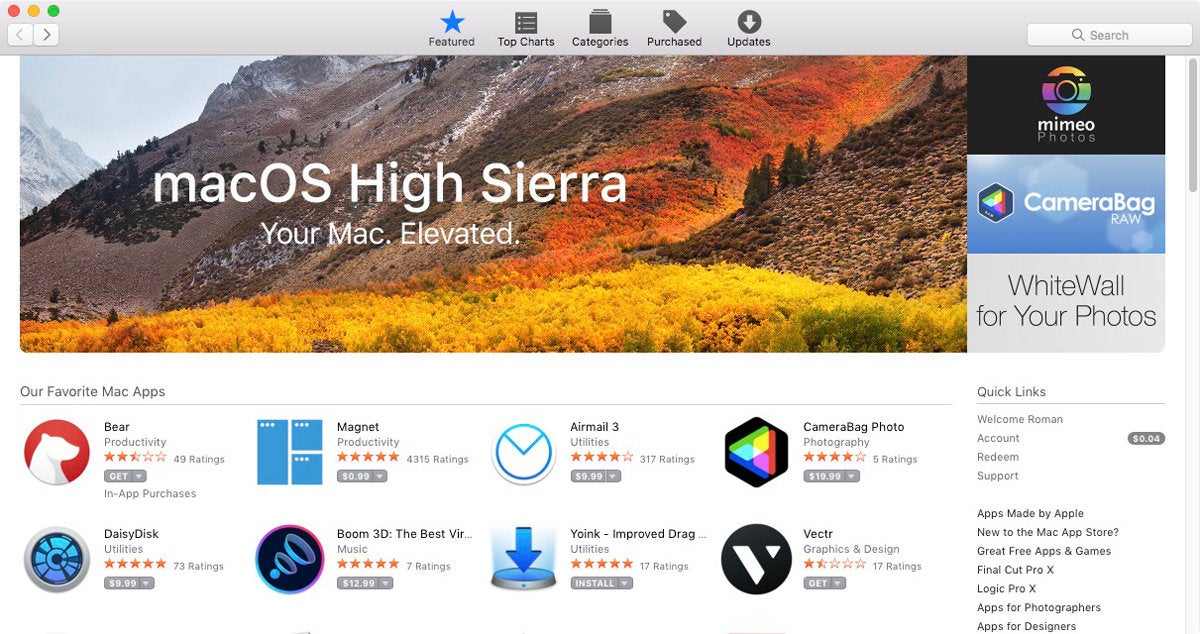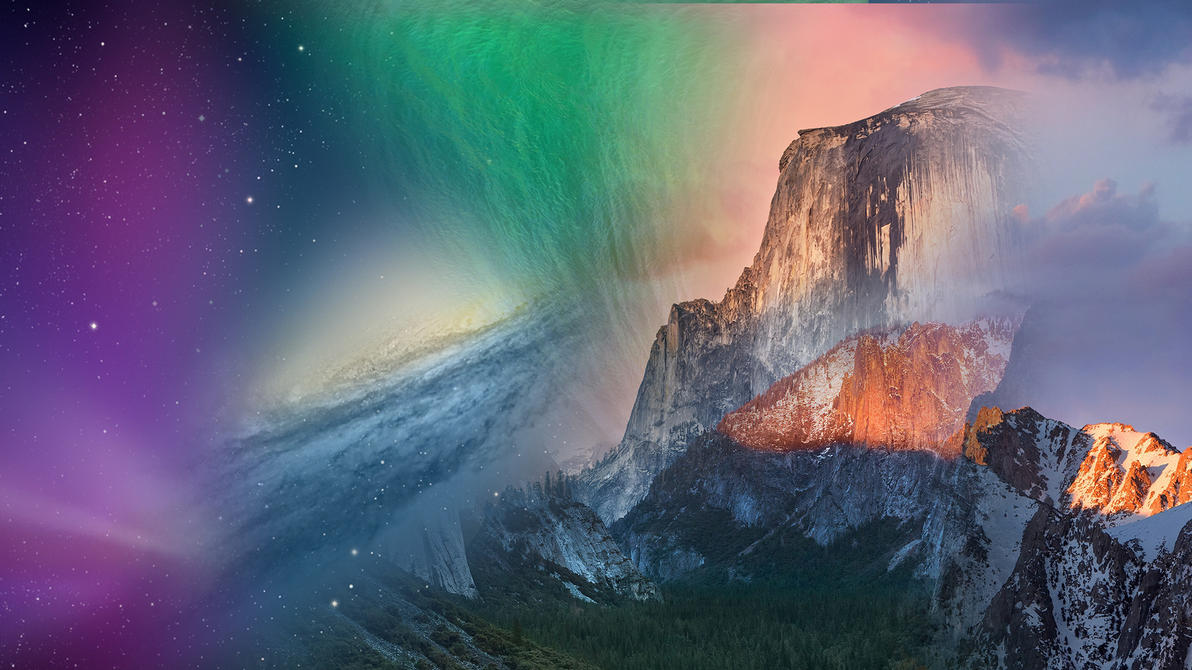- How to install macOS High Sierra. Launch the App Store app, located in your Applications folder. Look for macOS High Sierra in the App Store. You can also do a search, but you’ll.
- That’s was for installing High Sierra on Mac. But for installing macOS High Sierra on Windows, which you definitely can, there are two ways to do it. In the first procedure, we can install macOS High Sierra with High Sierra VMDK file. Here’s how to do it. In this procedure, we can install macOS High Sierra with macOS High Sierra ISO.
- From the App Store, grab the High Sierra installer. It will launch 'Install macOS High Sierra' after the download completes. Click 'Continue', accept the licensing agreement, select the install drive, then the installer will prompt for an admin password. After that, it will begin downloading to '/macOS Install Data' on the local machine.
- Blackberry Link Mac Os High Sierra
- Mac Os High Sierra Problems
- Link For Mac Os High Sierra 10.13
- Sierra Mac Os
First click on this link and download the High Sierra patcher application. The above link will give you a file named macOS High Sierra Patcher.dmg. Simply open this file and you will see a new window. Now again open the icon named macOS High Sierra Patcher inside the window.
These advanced steps are primarily for system administrators and others who are familiar with the command line. You don't need a bootable installer to upgrade macOS or reinstall macOS, but it can be useful when you want to install on multiple computers without downloading the installer each time.


What you need to create a bootable installer
- A USB flash drive or other secondary volume, formatted as Mac OS Extended, with at least 12GB of available storage
- A downloaded installer for macOS Big Sur, Catalina, Mojave, High Sierra, or El Capitan
Download macOS
Blackberry Link Mac Os High Sierra

- Download: macOS Big Sur, macOS Catalina, macOS Mojave, or macOS High Sierra
These download to your Applications folder as an app named Install macOS [version name]. If the installer opens after downloading, quit it without continuing installation. To get the correct installer, download from a Mac that is using macOS Sierra 10.12.5 or later, or El Capitan 10.11.6. Enterprise administrators, please download from Apple, not a locally hosted software-update server. - Download: OS X El Capitan
This downloads as a disk image named InstallMacOSX.dmg. On a Mac that is compatible with El Capitan, open the disk image and run the installer within, named InstallMacOSX.pkg. It installs an app named Install OS X El Capitan into your Applications folder. You will create the bootable installer from this app, not from the disk image or .pkg installer.
Use the 'createinstallmedia' command in Terminal
- Connect the USB flash drive or other volume that you're using for the bootable installer.
- Open Terminal, which is in the Utilities folder of your Applications folder.
- Type or paste one of the following commands in Terminal. These assume that the installer is in your Applications folder, and MyVolume is the name of the USB flash drive or other volume you're using. If it has a different name, replace
MyVolumein these commands with the name of your volume.
Big Sur:*
Catalina:*
Mojave:*
High Sierra:*
El Capitan:
* If your Mac is using macOS Sierra or earlier, include the --applicationpath argument and installer path, similar to the way this is done in the command for El Capitan.
After typing the command:
- Press Return to enter the command.
- When prompted, type your administrator password and press Return again. Terminal doesn't show any characters as you type your password.
- When prompted, type
Yto confirm that you want to erase the volume, then press Return. Terminal shows the progress as the volume is erased. - After the volume is erased, you may see an alert that Terminal would like to access files on a removable volume. Click OK to allow the copy to proceed.
- When Terminal says that it's done, the volume will have the same name as the installer you downloaded, such as Install macOS Big Sur. You can now quit Terminal and eject the volume.
Use the bootable installer
Determine whether you're using a Mac with Apple silicon, then follow the appropriate steps:
Mac Os High Sierra Problems
Apple silicon
- Plug the bootable installer into a Mac that is connected to the internet and compatible with the version of macOS you're installing.
- Turn on your Mac and continue to hold the power button until you see the startup options window, which shows your bootable volumes and a gear icon labled Options.
- Select the volume containing the bootable installer, then click Continue.
- When the macOS installer opens, follow the onscreen instructions.
Intel processor
- Plug the bootable installer into a Mac that is connected to the internet and compatible with the version of macOS you're installing.
- Press and hold the Option (Alt) ⌥ key immediately after turning on or restarting your Mac.
- Release the Option key when you see a dark screen showing your bootable volumes.
- Select the volume containing the bootable installer. Then click the up arrow or press Return.
If you can't start up from the bootable installer, make sure that the External Boot setting in Startup Security Utility is set to allow booting from external media. - Choose your language, if prompted.
- Select Install macOS (or Install OS X) from the Utilities window, then click Continue and follow the onscreen instructions.
Learn more
For more information about the createinstallmedia command and the arguments that you can use with it, make sure that the macOS installer is in your Applications folder, then enter the appropriate path in Terminal:
- Big Sur: /Applications/Install macOS Big Sur.app/Contents/Resources/createinstallmedia
- Catalina: /Applications/Install macOS Catalina.app/Contents/Resources/createinstallmedia
- Mojave: /Applications/Install macOS Mojave.app/Contents/Resources/createinstallmedia
- High Sierra: /Applications/Install macOS High Sierra.app/Contents/Resources/createinstallmedia
- El Capitan: /Applications/Install OS X El Capitan.app/Contents/Resources/createinstallmedia

A bootable installer doesn't download macOS from the internet, but it does require an internet connection to get firmware and other information specific to the Mac model.
While the yearly major macOS update system is free to install, it is still limited to Macs that Apple deems compatible, and every year a generation of Macs essentially becomes obsolete. This is despite the fact that Apple is eager to emphasize that macOS is a widely compatible operating system.
As it happens, there are still people with close to ten-year-old Apple desktop computers still in use on a daily basis, likely performing a range of lighter tasks.
Link For Mac Os High Sierra 10.13
Download CleanMyMac X from MacPaw’s website and clean up to 500MB of junk data from your computer while enjoying all the features of the software without major limitations.

Which Macs Don't Support High Sierra
For some reason Apple doesn't want to allow these Macs to run one of its latest operating systems, namely macOS 10.13 High Sierra. This leaves the following Macs on macOS 10.11 El Capitan:
- MacBook Pro – late-2009 or earlier models
- MacBook – late-2008 or earlier models
- MacBook Air – 2009 or earlier models
- iMac – late-2008 or earlier models
- Mac Mini – 2009 or earlier models
- Mac Pro – 2009 or earlier models.
These machines are considered obsolete and vintage by Apple. The company defines vintage products as those that have not been manufactured for more than five years but less than seven years ago. Obsolete products are those discontinued more than seven years ago.
How To Install macOS High Sierra on Unsupported Macs
Though Apple doesn't support the above hardware officially, someone has thought about sharing the love for these older machines. A developer known as DOSDude1 has written a patch that works on Macs with the Penryn architecture. Using this still imposes certain limitations, but at least makes it possible to install macOS High Sierra on the following Macs:
- Early-2008 or newer Mac Pro, iMac, or MacBook Pro (MacPro 3,1 and 4,1, iMac 8,1 and 9,1, MacBook Pro 4,1, 5,1, 5,2, 5,3, 5,4, and 5,5).
- Late-2008 or newer MacBook Air or Aluminum Unibody MacBook (MacBook Air 2,1, MacBook 5,1).
- Early-2009 or newer Mac Mini or white MacBook (Mac Mini 3,1, MacBook 5,2)
- Early-2008 or newer Xserve (Xserve 2,1, Xserve 3,1).
If you happen to own any of the Penryn Macs mentioned above, the macOS High Sierra Patch Tool written by DOSDude1 will make running the latest software possible. But remember, with High Sierra you will also migrate to the Apple File System, and it is highly recommended that you first disable SIP because it may prevent the patch from working at all.
Installing the operating system on any of these Macs will require some technical knowledge, so it is not recommended for novice users. Also, a backup of your data is always a good idea in case anything goes wrong.
While there is a full step-by-step tutorial and video tutorial available on DOSDude1's website, it’s good to get a summary of the basics, which start with downloading the macOS High Sierra Installer app from the Mac App Store:
- Format a USB drive as Mac OS Extended (Journaled) via Disk Utility.
- Open the macOS High Sierra Patcher tool, navigate to the High Sierra Installer App, then select your pen drive and click “Start Operation”.
- Boot from the USB drive by holding down the option key after reboot.
- Install macOS normally, reboot back on the installer drive, and then open the “macOS Post Install” application.
- From the options, select the Mac model you own. This step is important, because it contains the optimal patch for that specific model.
- Click the “Patch” button, and after the process has finished, click “Reboot”.
The Reason Not To Install macOS High Sierra on an Unsupported Mac
As you may have already experienced with other types of officially unsupported machines, the probability of having issues is much higher. The same applies in this case, too, since the macOS High Sierra Patcher will render your iMac 8.1 Broadcom Wi-Fi chip useless for certain models.
Macs that use the Broadcom BCM4321 Wi-Fi module will not have functional Wi-Fi when running High Sierra. Another issue that has been highlighted by the developer is that the trackpad in the MacBook 5,2 isn't fully supported in this version of OS.
These are just a few of the possible issues that could arise, and this is before even mentioning the various potential software errors that you can run into by using out-of-date hardware. Without getting the proper knowledge beforehand, you'll need to revert back to the previous state of the Mac, which won't be an easy process, especially not without a Time Machine backup.
Sierra Mac Os
Best Mac Optimization Software of 2020
| Rank | Company | Info | Visit |
| |||
| |||
|
Get the Best Deals on Mac Optimization Software
Stay up to date on the latest tech news and discounts on Mac optimization software with our monthly newsletter.